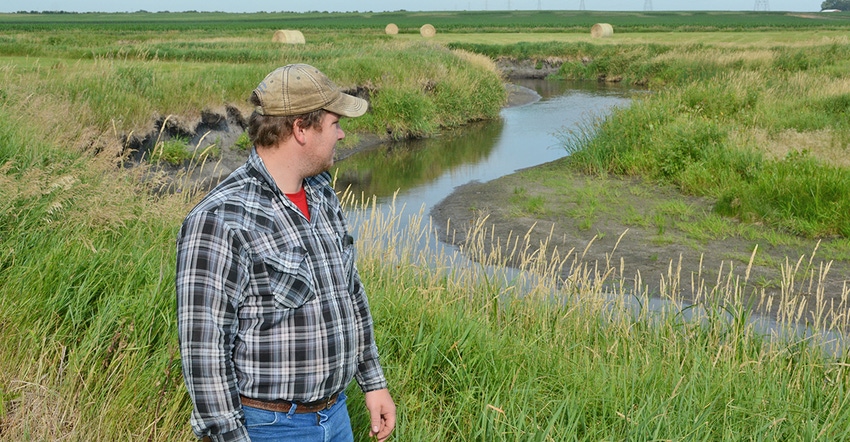July 25, 2017

Tony Gelderman is helping clean up Skunk Creek, a major tributary of the Big Sioux River that flows through the eastern third of South Dakota.
Gelderman, Hartford, S.D., enrolled a 90-acre pasture that straddles Skunk Creek into a unique, homegrown conservation program called S-RAM, or Seasonal Riparian Area Management. S-RAM has been so successful that it is being considered a model for other projects in the Dakotas and across the country.
One-time payment
S-RAM pays landowners $60 to $75 per acre over a 10- to 15-year period to defer grazing along the Big Sioux River and its tributaries from April 1 to Sept. 30.
Acres enrolled in the program can be hayed after June 1 and can be grazed after Oct. 1.
The program was a good fit for Gelderman, who has other pastures that he can use for summer grazing. He also needs grass hay. He feeds cows grass hay and distillers grains in the winter.
“The only other alternative was to put the pasture into CRP [Conservation Reserve Program],” Gelderman says, “but then I wouldn’t have been able to hay or graze it.”
Cleaner water
About 40% of the pastureland along Skunk Creek is enrolled in S-RAM, reports Barry Berg, East Dakota Water Development District watershed coordinator.
The district has monitoring stations along the creek. Tests show the water quality is much improved downstream from the S-RAM acres. In 2016, for the first time in four years, the sediment load dropped low enough that Skunk Creek was taken off the state’s impaired waters list for sediment.
Skunk Creek’s water enters the Big Sioux River in Sioux Falls, the state’s largest city. Sioux Falls has built parks and trails along the river. Recreational and environmental groups in South Dakota are pushing to make the river fishable and swimmable by 2020.
Though work on cleaning up the Big Sioux has been going on for some time, it’s been hard to make any real progress. All of the larger farms in the watershed that are required to have permits for their feedlots and livestock barns containing manure and runoff, so they don’t reach the river. But smaller farms don’t have to follow the same rules. Programs such as the Environmental Quality Incentive Program are available, but the producer cost-share portion may still be too expensive for many small operations to justify. Also, until S-RAM came along, there wasn’t a program to keep cattle on pasture out of the water that didn’t involve taking land out of production.
In 2012, Big Sioux River Watershed Project officials came up with the S-RAM idea. They ended up receiving about $1 million in grants from the state and $3 million from the city of Sioux Falls for the program.
Win for farmers, too
Some farmers have seen their herd’s average weaning weights rise as much as 25 pounds per head after enrolling in the S-RAM program. That’s because after they fenced off Skunk Creek, many took advantage of a 75% cost-share program and hooked up livestock waterers to rural water or private wells. The water is cleaner than what was in the creek, and the calves have gained more weight over the summer.
“S-RAM on Skunk Creek has been a win for conservationists and for farmers,” Berg says.
S-RAM details
The following are some of the details about S-RAM, or the Seasonal Riparian Area Management program:
• No grazing allowed April 1 through Sept. 30.
• Grazing allowed Oct. 1 through March 30.
• Haying allowed after June 1.
• A minimum of 4-6 inches of vegetative cover must be maintained on enrolled acres.
• Payment is $60-75 per acre for land that lies within the 100-year flood plain.
• Payment for acres outside of the 100-year flood plain is $30-$37 per acre.
• Contracts are for 10 to 15 years.
* Payment is made in full the first year of the contract.
• A 75% cost-share for fences and repair of damaged areas and livestock tracks is available.
• A 30% cost-share of alternative water sources such as rural water hook ups, wells, pipelines and tanks is available.
• A 50% cost-share is available for trees and fabric.
For more information about the program, contact Barry Berg, watershed coordinator, East Dakota Water Development District, 1307 N. Clark Ave., Dell Rapids, SD 57022; call 605-759-2650; email [email protected].
You May Also Like




